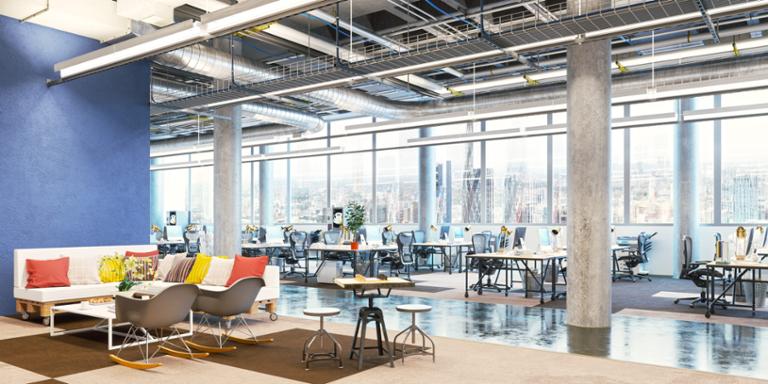 The sociometric badge used to measure open office behavior.[/caption] This research involved two field studies, both at Fortune 500 multinational companies that underwent a redesign that brought down office walls and opened space up to cubicles. Thanks to that transition, researchers were able to get a before-and-after look at how open offices affect workers. They found face-to-face interactions decreased roughly 70 percent as the office opened up, writing: "Rather than prompting increasingly vibrant face-to-face collaboration, open architecture appeared to trigger a natural human response to socially withdraw from officemates and interact instead over email and IM.” Participants send 56 percent more email, received 20 percent more email, and were cc:’d on 41 percent more email. Instant message (IM) use increased 75 percent (this metric counted words, so people sent 75 percent more words via IM). As researchers stated: “In boundaryless space, electronic interaction replaced F2F interaction.” But we knew this would happen, didn’t we? In 2016, we wrote those working in an open office should “seek refuge” and email coworkers who might ask to speak face-to-face too often. Separate surveys show we’re just not open to the idea of open offices. For many, open offices aren't even a concept tolerable in flashy jobs. Facebook’s massive open office concept was widely panned as a step too far, and Apple’s own ‘spaceship’ campus was reportedly hated by its engineering teams. At this juncture, we have to wonder if companies will get wise and start offering proper offices again. People seem to hate the idea of open offices, and we now have empirical data showing we don’t work better or differently in an open environment.
The sociometric badge used to measure open office behavior.[/caption] This research involved two field studies, both at Fortune 500 multinational companies that underwent a redesign that brought down office walls and opened space up to cubicles. Thanks to that transition, researchers were able to get a before-and-after look at how open offices affect workers. They found face-to-face interactions decreased roughly 70 percent as the office opened up, writing: "Rather than prompting increasingly vibrant face-to-face collaboration, open architecture appeared to trigger a natural human response to socially withdraw from officemates and interact instead over email and IM.” Participants send 56 percent more email, received 20 percent more email, and were cc:’d on 41 percent more email. Instant message (IM) use increased 75 percent (this metric counted words, so people sent 75 percent more words via IM). As researchers stated: “In boundaryless space, electronic interaction replaced F2F interaction.” But we knew this would happen, didn’t we? In 2016, we wrote those working in an open office should “seek refuge” and email coworkers who might ask to speak face-to-face too often. Separate surveys show we’re just not open to the idea of open offices. For many, open offices aren't even a concept tolerable in flashy jobs. Facebook’s massive open office concept was widely panned as a step too far, and Apple’s own ‘spaceship’ campus was reportedly hated by its engineering teams. At this juncture, we have to wonder if companies will get wise and start offering proper offices again. People seem to hate the idea of open offices, and we now have empirical data showing we don’t work better or differently in an open environment. New Proof the Open Office Concept is Ineffective
Few people like an open office floor plan, and a new study suggests its design has little effect on how we work. The theory of open office plans is that the humans occupying such spaces will become more collaborative, and increase their face-to-face interactions. It’s a utopian thought; instead of crouching behind our monitors, we’re supposed to be laughing and sharing quips (and work info) with friends at each others’ desks. That’s just not how any of this works, though. The study, published by Royal Society Publishing, used a badge (the “sociometric” badge, if you’re curious) with a microphone, infrared sensor, accelerometer, and bluetooth capabilities. This badge helped researchers discover how people in open offices actually interacted and worked. The team was also allowed to view metadata from company email servers for study participants (i.e., metrics such as volume of email sent). The sociometric badge used the microphone to determine if the person wearing it was actually interacting with others, though it didn’t record the content of conversations; the infrared sensor interfaced with sensors on other badges to learn if two participants were standing face-to-face, suggesting they were interacting. Accelerometers captured body movement and posture, while bluetooth handled spatial location. [caption id="attachment_182141" align="aligncenter" width="1211"]  The sociometric badge used to measure open office behavior.[/caption] This research involved two field studies, both at Fortune 500 multinational companies that underwent a redesign that brought down office walls and opened space up to cubicles. Thanks to that transition, researchers were able to get a before-and-after look at how open offices affect workers. They found face-to-face interactions decreased roughly 70 percent as the office opened up, writing: "Rather than prompting increasingly vibrant face-to-face collaboration, open architecture appeared to trigger a natural human response to socially withdraw from officemates and interact instead over email and IM.” Participants send 56 percent more email, received 20 percent more email, and were cc:’d on 41 percent more email. Instant message (IM) use increased 75 percent (this metric counted words, so people sent 75 percent more words via IM). As researchers stated: “In boundaryless space, electronic interaction replaced F2F interaction.” But we knew this would happen, didn’t we? In 2016, we wrote those working in an open office should “seek refuge” and email coworkers who might ask to speak face-to-face too often. Separate surveys show we’re just not open to the idea of open offices. For many, open offices aren't even a concept tolerable in flashy jobs. Facebook’s massive open office concept was widely panned as a step too far, and Apple’s own ‘spaceship’ campus was reportedly hated by its engineering teams. At this juncture, we have to wonder if companies will get wise and start offering proper offices again. People seem to hate the idea of open offices, and we now have empirical data showing we don’t work better or differently in an open environment.
The sociometric badge used to measure open office behavior.[/caption] This research involved two field studies, both at Fortune 500 multinational companies that underwent a redesign that brought down office walls and opened space up to cubicles. Thanks to that transition, researchers were able to get a before-and-after look at how open offices affect workers. They found face-to-face interactions decreased roughly 70 percent as the office opened up, writing: "Rather than prompting increasingly vibrant face-to-face collaboration, open architecture appeared to trigger a natural human response to socially withdraw from officemates and interact instead over email and IM.” Participants send 56 percent more email, received 20 percent more email, and were cc:’d on 41 percent more email. Instant message (IM) use increased 75 percent (this metric counted words, so people sent 75 percent more words via IM). As researchers stated: “In boundaryless space, electronic interaction replaced F2F interaction.” But we knew this would happen, didn’t we? In 2016, we wrote those working in an open office should “seek refuge” and email coworkers who might ask to speak face-to-face too often. Separate surveys show we’re just not open to the idea of open offices. For many, open offices aren't even a concept tolerable in flashy jobs. Facebook’s massive open office concept was widely panned as a step too far, and Apple’s own ‘spaceship’ campus was reportedly hated by its engineering teams. At this juncture, we have to wonder if companies will get wise and start offering proper offices again. People seem to hate the idea of open offices, and we now have empirical data showing we don’t work better or differently in an open environment.
 The sociometric badge used to measure open office behavior.[/caption] This research involved two field studies, both at Fortune 500 multinational companies that underwent a redesign that brought down office walls and opened space up to cubicles. Thanks to that transition, researchers were able to get a before-and-after look at how open offices affect workers. They found face-to-face interactions decreased roughly 70 percent as the office opened up, writing: "Rather than prompting increasingly vibrant face-to-face collaboration, open architecture appeared to trigger a natural human response to socially withdraw from officemates and interact instead over email and IM.” Participants send 56 percent more email, received 20 percent more email, and were cc:’d on 41 percent more email. Instant message (IM) use increased 75 percent (this metric counted words, so people sent 75 percent more words via IM). As researchers stated: “In boundaryless space, electronic interaction replaced F2F interaction.” But we knew this would happen, didn’t we? In 2016, we wrote those working in an open office should “seek refuge” and email coworkers who might ask to speak face-to-face too often. Separate surveys show we’re just not open to the idea of open offices. For many, open offices aren't even a concept tolerable in flashy jobs. Facebook’s massive open office concept was widely panned as a step too far, and Apple’s own ‘spaceship’ campus was reportedly hated by its engineering teams. At this juncture, we have to wonder if companies will get wise and start offering proper offices again. People seem to hate the idea of open offices, and we now have empirical data showing we don’t work better or differently in an open environment.
The sociometric badge used to measure open office behavior.[/caption] This research involved two field studies, both at Fortune 500 multinational companies that underwent a redesign that brought down office walls and opened space up to cubicles. Thanks to that transition, researchers were able to get a before-and-after look at how open offices affect workers. They found face-to-face interactions decreased roughly 70 percent as the office opened up, writing: "Rather than prompting increasingly vibrant face-to-face collaboration, open architecture appeared to trigger a natural human response to socially withdraw from officemates and interact instead over email and IM.” Participants send 56 percent more email, received 20 percent more email, and were cc:’d on 41 percent more email. Instant message (IM) use increased 75 percent (this metric counted words, so people sent 75 percent more words via IM). As researchers stated: “In boundaryless space, electronic interaction replaced F2F interaction.” But we knew this would happen, didn’t we? In 2016, we wrote those working in an open office should “seek refuge” and email coworkers who might ask to speak face-to-face too often. Separate surveys show we’re just not open to the idea of open offices. For many, open offices aren't even a concept tolerable in flashy jobs. Facebook’s massive open office concept was widely panned as a step too far, and Apple’s own ‘spaceship’ campus was reportedly hated by its engineering teams. At this juncture, we have to wonder if companies will get wise and start offering proper offices again. People seem to hate the idea of open offices, and we now have empirical data showing we don’t work better or differently in an open environment. 

